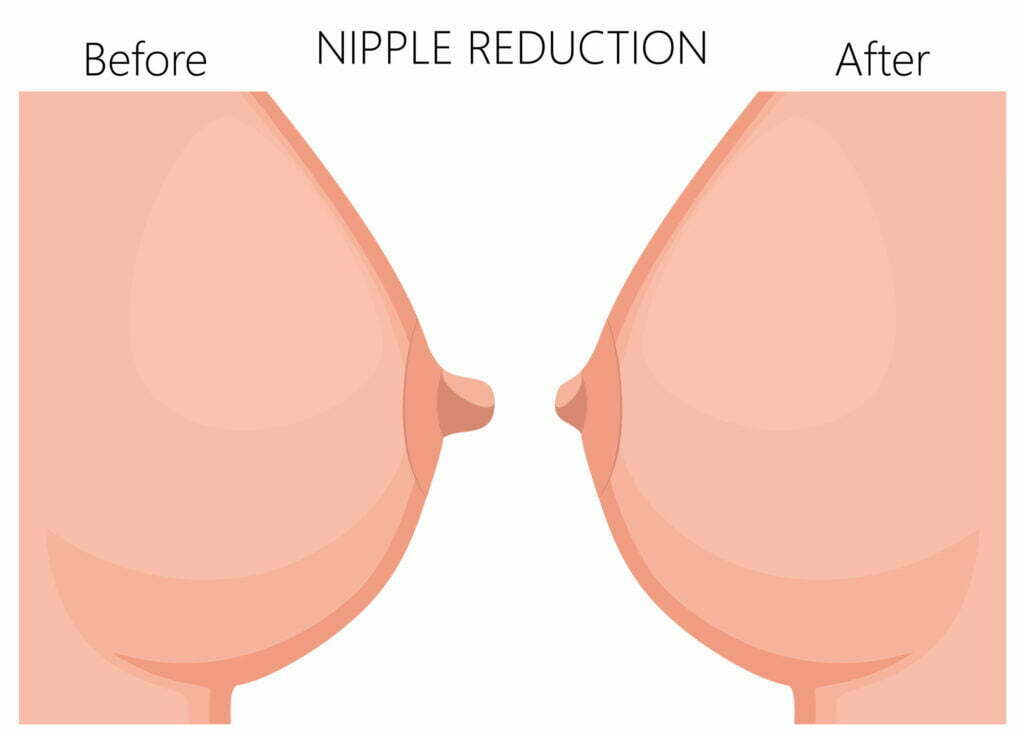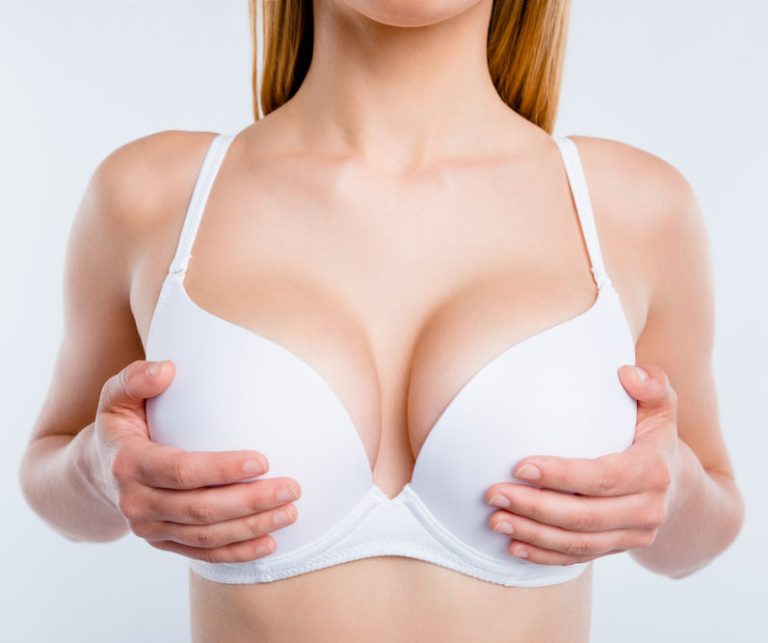Beyond Size: Navigating the Emotional and Physical Aspects of Nipple Reduction
Posted on: February 8, 2024
Nipple reduction is a cosmetic procedure aimed at altering the size or shape of the nipples, catering to those who seek a more proportionate look. This surgical option not only enhances aesthetic appeal but also boosts self-confidence for many individuals. As societal norms and personal beauty standards evolve, the demand for such specialized cosmetic interventions has seen a significant uptick. Understanding the nuances, potential outcomes, and considerations of nipple reduction is crucial for anyone contemplating this procedure. It’s about aligning physical appearance with one’s self-perception in a safe and informed manner.
Understanding Nipple Reduction and Areola Techniques
Procedure Differences
Nipple reduction and areola resizing are two distinct procedures. Both aim to enhance the breast’s appearance but focus on different parts.
Nipple reduction targets the nipple itself, making it smaller or shorter. This is often sought by those who feel their nipples are too long or protrude too much. On the other hand, areola resizing involves altering the dark skin surrounding the nipple. People opt for this when they find their areolas too large or stretched out.
Common Methods
Several methods exist for both types of surgery, each with its own approach.
For nipple reduction, surgeons might use:
- Direct excision: cutting away excess tissue directly.
- The wedge method: removing a pie-shaped piece to reduce length.
Areola resizing typically involves:
- Circular incisions around the areola to remove outer skin.
- Sutures that tighten and reshape the area.
Both procedures can be done under local anesthesia and usually take about an hour.
Goals Achieved
Understanding aesthetic and functional goals is crucial before undergoing these surgeries.
Aesthetically, patients seek a more proportionate look between their nipples/areolas and breasts. They want to feel confident in various clothing styles without feeling self-conscious about how their nipples or areolas appear.
Functionally, reducing overly large nipples can prevent irritation from rubbing against fabric. Similarly, adjusting enlarged areolas helps regain a more youthful appearance after pregnancy or weight changes have altered them.
Ideal Candidates for Nipple Reduction
Genetic Factors
Individuals with enlarged nipples due to genetics may feel their nipple size is out of proportion. This can affect both men and women, making them self-conscious about their appearance. A reduction can help achieve a more balanced look.
For those born with larger nipples, the desire for a natural look drives them towards this procedure. It’s not just about aesthetics; it’s about feeling comfortable in one’s skin.
Aging and Breastfeeding
Aging and breastfeeding significantly change breast size and shape. They often lead to enlarged nipples as well. Women post-breastfeeding find that nipple reduction can restore a pre-pregnancy appearance.
This procedure helps in achieving symmetry between breasts too. Many seek this correction after noticing changes due to aging or after having children.
Health and Expectations
Candidates must be in good health and non-smokers. Smoking affects healing, so quitting is crucial before undergoing surgery.
Realistic expectations are key. An expert will aim for improvement, not perfection. The goal is an ideal nipple size that complements your breast size and overall body proportions.
- Pros of being an ideal candidate:
- Achieves better symmetry
- Enhances natural look
- Boosts self-confidence
- Cons:
Surgical Techniques for Nipple Reduction
Circular Technique
The circular technique is a common method for nipple reduction. It focuses on reducing the nipple’s height. A plastic surgeon removes a ring of tissue from the tip of the nipple. This process shortens its length.
This technique ensures minimal scarring. It preserves most of the nipple’s natural shape and function. Patients often choose this method when they seek a subtle change.
Wedge Method
The wedge method targets decreasing nipple width. Surgeons cut out a small wedge-shaped piece from the sides of the nipple. They then stitch it back together.

This approach helps in achieving a narrower appearance without significant height alteration. It is suitable for those looking to correct wide or flared nipples following breast procedures like augmentation mammaplasty or breast reduction surgery.
Anesthesia Requirements
Local anesthesia is typically required for both techniques mentioned above.
- Ensures patient comfort during surgery
- Allows quick recovery post-procedure
Most patients report minimal discomfort during these surgical procedures, thanks to local anesthesia.
Recovery Process After Nipple Reduction
Initial Period
The initial recovery period for nipple reduction typically lasts from one to two weeks. Patients may experience some discomfort during this time. However, it’s crucial to rest and allow the body to heal.
Doctors usually prescribe medication to manage pain after surgery. Following their advice is essential for a smooth recovery.
Post-Operative Care
Following post-operative care instructions is vital for minimizing scarring after nipple reduction. These guidelines include keeping the area clean and avoiding strenuous activities that might stress the surgical site.
Patients should also wear recommended support garments if instructed by their surgeon. This helps in reducing swelling and supports healing.
Here are key points on post-operative care:
- Keep surgical sites clean.
- Avoid heavy lifting or vigorous exercise.
- Wear any prescribed support garments.
These steps ensure a better healing process with minimal complications.
Risks and Complications of Nipple Reduction
Potential Risks
Nipple reduction, like any surgery, comes with its own set of risks. Infection is a primary concern. It can delay healing and cause discomfort. Bleeding is another risk that might occur during or after the procedure. There’s also the chance of adverse reactions to anesthesia, though rare.
Patients should be aware of these risks before undergoing surgery. They must follow their surgeon’s advice closely to minimize complications.
Sensation Changes
Changes in nipple sensation are possible after surgery. Some patients report increased sensitivity, while others experience numbness or reduced sensation.
These changes can be temporary or permanent. Discussing this possibility with your surgeon beforehand is important.
Uneven Results
Uneven nipple sizes or shapes post-surgery are rare but possible outcomes. This could result from natural asymmetry being more noticeable after reduction.
If unevenness occurs, corrective surgery might be necessary. Patients should consider this potential complication when deciding on the procedure.
Nipple Sensitivity and Breastfeeding Post-Surgery
Altered Sensitivity
After nipple reduction, changes in nipple sensitivity can occur. This is due to the surgery’s impact on the intercostal nerves, which are responsible for feeling in this area. Some patients report increased sensitivity, while others experience a decrease.
The outcome varies greatly among individuals. The primary innervation of the nipple comes from these intercostal nerves. If they are affected during surgery, it can lead to changes in how sensations are felt. Applying antibacterial ointment post-surgery helps in healing but does not directly affect sensitivity levels.
Breastfeeding Impact
Concerns about breastfeeding after nipple reduction are common. The ability to produce enough milk depends on many factors including the preservation of breast tissue and ducts during surgery.
- Most women can still breastfeed if key structures remain intact.
- Discussing future pregnancy plans with your surgeon is crucial before undergoing nipple reduction.
It’s important to note that every woman’s body reacts differently to surgery. While some may experience no change in their breastfeeding capabilities, others might face challenges. Surgeons aim to preserve as much functionality as possible by minimizing damage to breast tissue and maintaining connectivity within milk ducts.
Emotional and Physical Experience After Surgery
Psychological Benefits
After undergoing nipple reduction, many patients report a significant boost in self-confidence. This is largely due to the improved body image satisfaction they experience. The aesthetic results can profoundly affect one’s mental health, reducing psychological distress.
The excitement of seeing the new appearance contributes positively to one’s emotional well-being. However, it’s important for patients to have realistic expectations about the outcomes. Patience plays a crucial role here as final results take time to manifest.
Physical Adjustments
Post-surgery, patients encounter several physical adjustments related to their new nipple size or shape. Initially, there might be mild discomfort, swelling around the surgical site, and visible scarring. These are normal parts of the healing process.
Adapting to these changes requires patience and following postoperative care instructions closely. Avoiding strenuous exercise and taking care of the wound can speed up recovery. Over time, most physical symptoms like excess skin or swelling diminish significantly.
- Healing takes time; final aesthetic outcomes may not be immediate.
- Postoperative day care is crucial for minimizing complications.
Patients should also note that while nipple sensitivity was discussed previously, this surgery primarily focuses on improving overall appearance rather than sensory function.
Long-Term Care and Lifestyle Changes Post-Surgery
Sun Protection
After nipple reduction, sun protection is crucial. The skin around the surgery area can discolor if exposed to the sun too much. Patients should use sunscreen on their scars when outside.
Wearing protective clothing also helps prevent discoloration. This includes long-sleeved shirts and hats.
Weight Management
Maintaining a stable weight is key for lasting results. Gaining or losing weight can affect how your surgery looks over time.
Patients are advised to follow a balanced diet and exercise regularly. These efforts help keep the results of your nipple reduction looking good.
Regular Follow-Ups
Seeing your surgeon for follow-ups is important for healing well. They check how your wounds are healing and make sure there are no complications.
During these visits, patients can discuss any concerns with their surgeon or nursing team. It’s also a chance to talk about any needed adjustments in wound care or lifestyle changes.
Summary
Nipple reduction surgery offers a solution for individuals seeking to alter the size or shape of their nipples, enhancing both comfort and confidence. This procedure, suitable for certain candidates, involves specific surgical techniques tailored to individual needs and desires. Recovery, while requiring careful attention to instructions from healthcare providers, typically leads to satisfactory outcomes. However, potential risks and complications must be considered, alongside the impact on nipple sensitivity and the ability to breastfeed. The emotional and physical journey post-surgery can significantly improve one’s self-image and quality of life, provided long-term care and lifestyle adjustments are embraced.
For those contemplating nipple reduction, understanding the comprehensive process—from candidacy through recovery and beyond—is crucial. Consulting with a qualified plastic surgeon can provide clarity on expectations, outcomes, and tailored care plans. If you’re considering this transformative step towards personal satisfaction and well-being, reach out to a healthcare professional today to discuss your options.
Frequently Asked Questions
Who is an ideal candidate for nipple reduction surgery?
An ideal candidate for nipple reduction surgery is someone in good overall health, with realistic expectations about the outcomes. Individuals who are bothered by the size or shape of their nipples and looking to achieve a more proportional breast appearance may consider this procedure.
What surgical techniques are used in nipple reduction?
Surgical techniques for nipple reduction vary but often involve removing excess tissue from the nipple itself or the surrounding area to reduce size and improve shape. The specific method depends on individual goals and anatomy.
How long does recovery take after a nipple reduction?
Recovery time can vary, but most patients return to normal activities within 1-2 weeks post-surgery. Complete healing and final results might take longer, with swelling subsiding over several months.
What are some risks associated with nipple reduction surgery?
Risks include infection, bleeding, scarring, changes in sensation, and dissatisfaction with aesthetic outcomes. As with any surgery, following your surgeon’s post-operative care instructions can minimize these risks.
Can I still breastfeed after undergoing a nipple reduction?
While many women can breastfeed after a nipple reduction, there’s a risk that milk ducts could be affected during surgery which might impact breastfeeding capabilities. Discuss potential impacts on breastfeeding with your surgeon pre-operatively.
How does one manage long-term care after undergoing a nipplereduction?
Long-term care involves monitoring any changes in sensitivity or appearance around the treated area while maintaining healthy lifestyle habits. Regular follow-ups as recommended by your surgeon ensure lasting satisfaction with results.
Does undergoing a nipplereduction affect emotional well-being?
Post-surgery experiences vary; however, many individuals report improved self-esteem and body image once fully recovered. It’s important to have support systems in place for both physical recovery and emotional well-being throughout the process.





